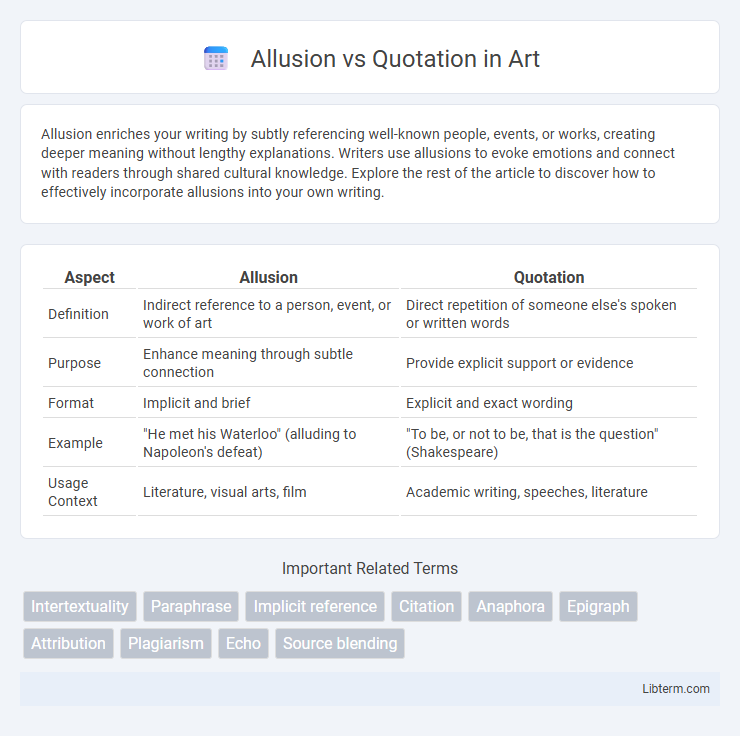Allusion enriches your writing by subtly referencing well-known people, events, or works, creating deeper meaning without lengthy explanations. Writers use allusions to evoke emotions and connect with readers through shared cultural knowledge. Explore the rest of the article to discover how to effectively incorporate allusions into your own writing.
Table of Comparison
| Aspect | Allusion | Quotation |
|---|---|---|
| Definition | Indirect reference to a person, event, or work of art | Direct repetition of someone else's spoken or written words |
| Purpose | Enhance meaning through subtle connection | Provide explicit support or evidence |
| Format | Implicit and brief | Explicit and exact wording |
| Example | "He met his Waterloo" (alluding to Napoleon's defeat) | "To be, or not to be, that is the question" (Shakespeare) |
| Usage Context | Literature, visual arts, film | Academic writing, speeches, literature |
Understanding Allusions: Definition and Purpose
An allusion is a brief, indirect reference to a person, event, or work of literature, designed to evoke deeper meaning without explicit explanation. Its purpose is to enrich the text by connecting it to broader cultural or historical contexts, allowing readers to draw meaningful parallels and insights. Unlike a direct quotation, an allusion relies on the audience's prior knowledge to enhance understanding and resonance within the narrative.
What Is a Quotation? Key Characteristics
A quotation is a verbatim excerpt taken directly from a source, maintaining the original wording, punctuation, and context. It provides clear attribution to the original author and typically requires quotation marks to distinguish it from the rest of the text. Key characteristics of a quotation include exact replication, source citation, and the ability to support or enhance the writer's argument through authoritative evidence.
Allusion vs Quotation: Core Differences
Allusion involves indirectly referencing a person, event, or text to evoke an idea or theme without explicit mention, relying on the audience's familiarity for meaning. Quotation directly cites specific words or passages from a source, providing exact replication and clear attribution. The core difference lies in allusion's subtlety and interpretive reliance versus quotation's precision and explicit acknowledgment.
How Allusions Enhance Writing
Allusions enhance writing by subtly referencing well-known texts, historical events, or cultural landmarks, enriching the reader's understanding without explicit explanation. This technique creates layers of meaning, allowing authors to evoke emotions and ideas efficiently while engaging readers through shared knowledge. By invoking familiar concepts, allusions deepen thematic resonance and add complexity to the narrative or argument.
The Power of Direct Quotations
Direct quotations hold significant power by providing exact words from a source, lending authenticity and authority to writing. They allow writers to capture the original tone, context, and emotion, making arguments more compelling and credible. Unlike allusions, which rely on indirect references, direct quotations offer precise evidence that strengthens textual analysis and supports critical interpretations effectively.
Recognizing Allusions in Literature and Speech
Recognizing allusions in literature and speech involves understanding indirect references to well-known events, texts, or cultural elements that enrich meaning without explicit explanation. Allusions rely on the audience's familiarity with the source material, contrasting with quotations that directly reproduce exact words for clarity and emphasis. Identifying allusions requires contextual knowledge, careful reading, and awareness of common literary, historical, or mythological references embedded in the text or dialogue.
Citing Quotations: Rules and Best Practices
Citing quotations requires exact replication of the original text within quotation marks, along with proper attribution to the source to maintain academic integrity and avoid plagiarism. Best practices include providing the author's name, publication year, and page number in the citation, following style guides such as APA, MLA, or Chicago. Allusions, by contrast, reference ideas or themes indirectly and do not require quotation marks or exact citations but should still be acknowledged to give credit and context.
Common Mistakes: Allusion and Quotation Confusion
Confusing allusion with quotation often leads to misinterpretation, as allusions hint indirectly at sources without explicit citation, while quotations reproduce exact words from a text. Common mistakes include failing to recognize allusions, which can obscure the original reference, or misrepresenting quotations by paraphrasing them inaccurately. Proper differentiation enhances clarity and preserves the integrity of the referenced material in academic and literary contexts.
When to Use Allusion vs Quotation
Use allusion when you want to evoke a concept or theme subtly, relying on the audience's ability to recognize indirect references without explicit citation. Quotation is appropriate when you need to provide exact language or authoritative evidence to support an argument or enhance credibility. Choose allusion for enhancing literary depth and quotation for clear validation or demonstration of a source.
Examples of Effective Allusions and Quotations
Effective allusions subtly reference well-known literary works, historical events, or cultural icons, such as a novel mentioning "Achilles' heel" to denote vulnerability without detailed explanation. Quotations directly incorporate exact phrases or sentences, like Martin Luther King Jr.'s "I have a dream" speech, to invoke authoritative support or emotional resonance. Using allusions and quotations strategically enhances writing by enriching context and adding depth through recognizable and meaningful references.
Allusion Infographic

 libterm.com
libterm.com